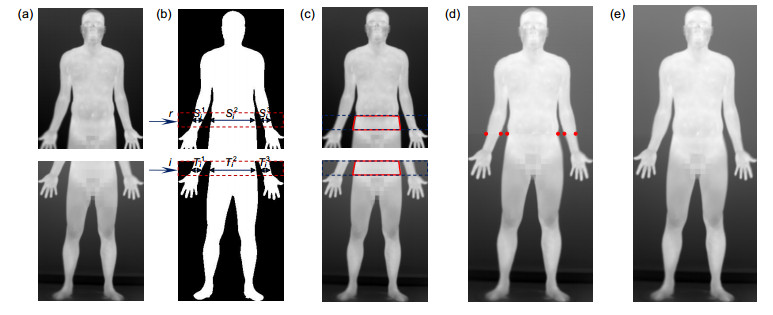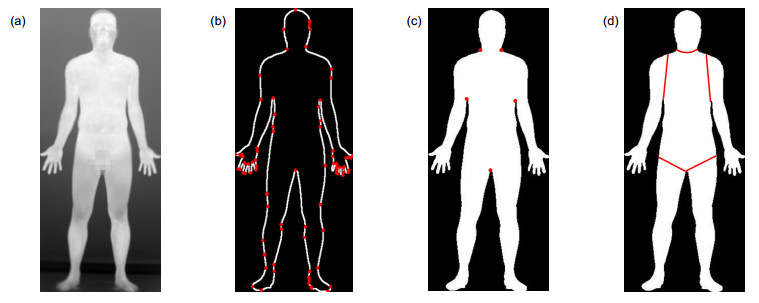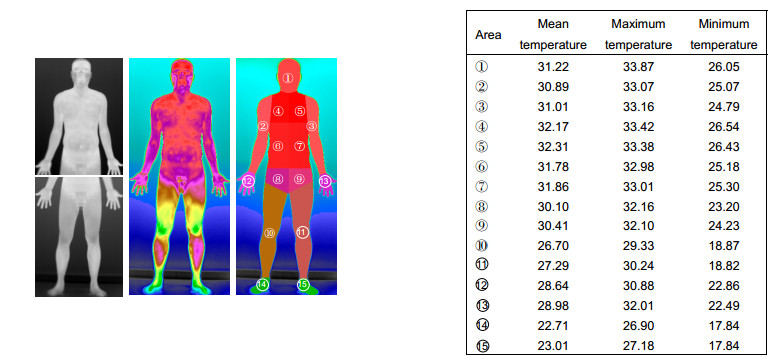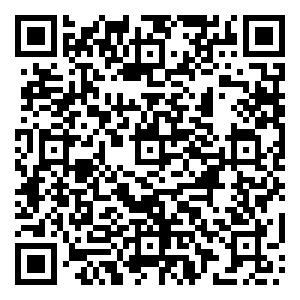-
摘要:
人体医学热红外图像直观反映了人体表面的温度分布,通过对红外图像进行深入分析能够提供智能化疾病辅助诊断依据。本文根据实际医学红外图像分析的需要,提出了上下半身图像拼接和人体部位划分两种预处理算法。在图像拼接阶段,根据图像采集环境的实际情况,首先对图像进行局部阈值分割,然后采用二值和灰度模板对上下半身图像进行对齐和融合。在区域划分阶段,通过对人体轮廓线进行极值点扫描确定部位区域关键点,并将人体图像划分成头部、躯干及四肢等区域。实验表明,本文所提出的红外图像预处理方法能获得满意的图像拼接及部位划分结果,可有效支持人体温度分布的定量及定性分析。
 Abstract:
Abstract:The thermal infrared image of the human body directly reflects the temperature distribution of the human body surface. Based on in-depth analysis, the infrared image can provide intelligent diagnosis assistance for human diseases. This paper proposed two preprocessing algorithms, i.e., upper-lower body image-stitching and body image partitioning, for medical infrared image analysis. In the image stitching stage, the human body is first extracted from the background by local thresholding based on the characteristics of the actual imaging environment. Then the upper and lower body images are aligned and fused using binary and grayscale template matching. In the image partitioning stage, the key points of the part area are determined by the extremum-point analysis of the human contour. The human body is then partitioned into regions including head, trunk, limbs, etc. Experiments show that the proposed preprocessing algorithms produce satisfactory results in image-stitching and portioning, and can effectively support the quantitative and qualitative analysis of human body temperature distribution.
-

Overview: Body temperature in medicine is a parameter indicating abnormal activity of human tissues. Over the past few decades, the thermal infrared image of human has attracted extensive interest because it directly reflects the temperature distribution of the human body surface. Based on in-depth analysis, the infrared image can be used to diagnose specific pathologies. In order to carry out thermal infrared image analysis, we need to obtain a complete human body image and perform the correct segmentation of human body parts.
However, efficient algorithms for image stitching and partition of the infrared image are facing challenges and it is worthwhile devoting much effort to this. As can be seen in the picture above, the temperature distribution of the human body in the infrared image is not uniform, the background temperature varies from top to bottom. In addition, the upper and lower body infrared images are not collected at the same time. Thus, the arms may not be in the same position. In the literature, there are three kinds of algorithms for image registration, i.e., feature-based, intensity-based, and transform-based. As infrared thermal human-body images are of limited resolution, low contrast, and barely noticeable texture, the traditional feature-based algorithm cannot work properly. As the position of the arm may be inconsistent, phase correlation algorithm may cause a large error. Among them, intensity-based algorithm is a preferable method, but some existing problems still need to be solved. On the other part, human feature point extraction algorithms mainly include line-by-line scanning and chain-code-based methods, etc., but they are susceptible to noise.
In an effort to overcome these challenges, we proposed two image processing algorithms. First, a template matching algorithm, which uses both binary and grayscale images, is proposed for image stitching. Second, the extreme point detection algorithm is employed to detect the key points. In the image stitching stage, first of all, we solved an accurate binary image for template matching. Based on the idea of Otsu algorithm, our method performs local threshold segmentation on infrared images by using a horizontal sliding window. Next, the starting line of the overlapping region is determined by the template matching with binarization images. The horizontal offset between the upper and lower body images is eliminated by the template matching with grayscale images. The arm area is registered by point matching in the binary image. Finally, the whole-body image is obtained by image fusion. In the image partitioning stage, the key points of the part area are determined by the extremum-point analysis of the human contour. The human body is then partitioned into regions including head, trunk, limbs, etc. Furthermore, the hand area of the human body is separated by a morphological operation. The separation of the foot area is performed similarly.
Experiments show that the proposed preprocessing algorithms produce satisfactory results in image-stitching and portioning. They can effectively support the quantitative and qualitative analysis of human body temperature distribution, which in turn provide intelligent diagnosis assistance for medical treatment.
-

-
图 6 上半身寻找关键点的曲线分析。(a)二值图中轴线至边界扫描示意图;(b)中轴线至边界的距离图;(c)中轴线至边界的距离梯度图
Figure 6. Curve analysis for searching the upper-body key points. (a) Schematic diagram of the boundary-scan from the central axis of the binary map; (b) Distance map from the central axis to the boundary; (c) Distance gradient from the central axis to the boundary
-
[1] 曹鼎汉.斯特藩-玻尔兹曼辐射定律及其应用[J].红外技术, 1994, 16(3): 46–48. http://www.cnki.com.cn/Article/CJFDTotal-HWJS403.014.htm
Cao D H. Sterling-Boltzmann radiation law and its application[J]. Infrared Technology, 1994, 16(3): 46–48. http://www.cnki.com.cn/Article/CJFDTotal-HWJS403.014.htm
[2] Jones B F, Plassmann P. Digital infrared thermal imaging of human skin[J]. IEEE Engineering in Medicine and Biology Magazine, 2002, 21(6): 41–48. doi: 10.1109/MEMB.2002.1175137
[3] Zaproudina N, Varmavuo V, Airaksinen O, et al. Reproducibility of infrared thermography measurements in healthy individuals[J]. Physiological Measurement, 2008, 29(4): 515–524. doi: 10.1088/0967-3334/29/4/007
[4] Ring E F J, Ammer K. Infrared thermal imaging in medicine[J]. Physiological Measurement, 2012, 33(3): R33–R46. http://d.old.wanfangdata.com.cn/Periodical/hwjs201406002
[5] Lowe D G. Distinctive image features from scale-invariant keypoints[J]. International Journal of Computer Vision, 2004, 60(2): 91–110. doi: 10.1023/B:VISI.0000029664.99615.94
[6] Bay H, Tuytelaars T, Van Gool L. SURF: Speeded up robust features[C]//Proceedings of the 9th European Conference on Computer Vision, Berlin, Heidelberg, 2006: 404–417.
[7] Sarvaiya J N, Patnaik S, Bombaywala S. Image registration by template matching using normalized cross-correlation[C]// Proceedings of 2009 International Conference on Advances in Computing, Control, and Telecommunication Technologies, Trivandrum, Kerala, India, 2009: 819–822.
[8] Hisham M B, Yaakob S N, Raof R A A, et al. Template matching using sum of squared difference and normalized cross correlation[C]//Proceedings of 2015 IEEE Student Conference on Research and Development, Kuala Lumpur, Malaysia, 2015: 100–104.
[9] 邓卫燕, 陆国栋, 王进, 等.基于图像的三维人体特征参数提取方法[J].浙江大学学报(工学版), 2010, 44(5): 837–840. doi: 10.3785/j.issn.1008-973X.2010.05.001
Deng W Y, Lu G D, Wang J, et al. Extraction of feature parameters of three-dimensional human body based on image[J]. Journal of Zhejiang University (Engineering Science), 2010, 44(5): 837–840. doi: 10.3785/j.issn.1008-973X.2010.05.001
[10] Lin Y L, Wang M J J. Automatic feature extraction from front and side images[C]//Proceedings of 2008 IEEE International Conference on Industrial Engineering and Engineering Management, Singapore, Singapore, 2008: 1949–1953.
[11] 卢晨.基于图像的非接触式人体测量系统研究与实现[D].镇江: 苏州大学, 2009.
Lu C. The study and implementation of image-based non-contacting human body auto-measurement system[D]. Zhenjiang: Suzhou University, 2009.
http://www.wanfangdata.com.cn/details/detail.do?_type=degree&id=Y1468729 [12] Otsu N. A threshold selection method from gray-level histograms[J]. IEEE Transactions on Systems, Man, and Cybernetics, 1979, 9(1): 62–66. doi: 10.1109/TSMC.1979.4310076
[13] Norollah M, Pourghassem H, Mahdavi-Nasab H. Image registration using template matching and similarity measures for dental radiograph[C]//Proceedings of the 4th International Conference on Computational Intelligence and Communication Networks, Mathura, India, 2012: 331–335.
[14] Ma L Y, Sun Y D, Feng N Z, et al. Image fast template matching algorithm based on projection and sequential similarity detecting[C]//Proceedings of the 5th International Conference on Intelligent Information Hiding and Multimedia Signal Processing, Kyoto, Japan, 2009: 957–960.
[15] Fouda Y, Ragab K. An efficient implementation of normalized cross-correlation image matching based on pyramid[C]// Proceedings of 2013 International Joint Conference on Awareness Science and Technology & Ubi-Media Computing, Aizu-Wakamatsu, Japan, 2013: 98–103.
[16] Zhang T X, He J. Source tracing of triple energizers[J]. Journal of Beijing University of Traditional Chinese Medicine, 2015, 38(11): 725–728, 731. http://www.wanfangdata.com.cn/details/detail.do?_type=perio&id=bjzyydxxb201511001
-


 E-mail Alert
E-mail Alert RSS
RSS

 下载:
下载:












